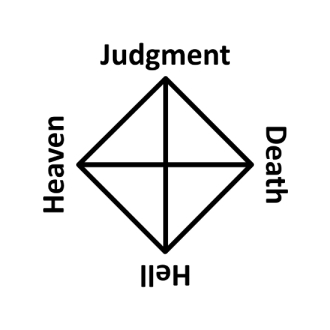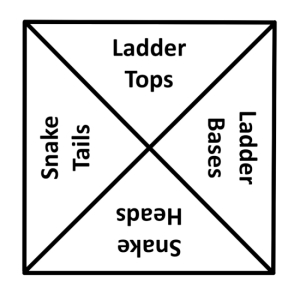
Many of the fourfolds presented here are roughly a combination of two dualities, a double dual if you will. Their diagrams could be considered as a crossed pair of rectangular cards, with each card showing a single pair of opposites. If one creates cards for every unique and important dual, new juxtapositions not thought of previously may be revealed by random and spontaneous association.
Of course many fourfolds cannot be reduced to the simple sum of their parts, or even the sum of their pairs. All four concepts often ramify themselves and each other due to binary, tertiary, and quaternary relations. Then the fourfold is greater than its individual constituents.
For example, the Four Elements are more than the opposite pairs of Air and Earth, Fire and Water. In Hjelmslev’s Net, Substance and Form combines with a superficially similar Content and Expression. However, above is an example of what I am striving for when Space and Time is combined with Matter and Energy.
Below is a list of dualities that might be used to create a useful set of cards. Some duals will come from fourfolds mentioned here but others will be new. Dualities or dichotomies are usually included in lists of opposites or antonyms, although they are usually more philosophical in nature.
Fourfolds that cannot be readily divided into two duals may by presented by square cards, perhaps called “trumps” or “major arcana” (or perhaps even “arcana quadra”). If cards are picked randomly but placed by choice, the rules of such actions must next be determined.
List of Duals (alphabetic):
Above, Below
Absence, Presence
Absolute, Relative
Abstract, Concrete
Active, Passive
Actual, Potential (Actual, Possible)
Addition, Subtraction
After, Before
All, None
Analytic, Synthetic
Answer, Question
And, Or
A Posteriori, A Priori
Artificial, Natural
Asymmetric, Symmetric
Atom, Void
Beautiful, Horrible
Begin, End (Start, Stop)
Being, Becoming
Belief (Faith), Doubt
Big, Little
Birth, Death
Black, White
Body, Mind
Bondage, Freedom
Bounded, Infinite
Cause, Effect
Chaos, Order (Discord, Harmony)
Child, Parent
Clean, Dirty
Combine, Separate
Complex, Simple
Content, Expression
Contingent, Necessary
Continuous, Discrete
Create, Destroy
Crooked, Straight
Dark, Light
Dawn, Dusk
Day, Night
Dead, Live
Decrease, Increase
Demand, Supply
Difference, Sameness (Distinction, Similarity)
Disease, Health (Sick, Well)
Division, Multiplication
Down, Up
Dynamic, Static
Electrical, Magnetic
Emotion, Reason (Irrational, Rational)
Empirical, Rational
Empty, Full
Enemy, Friend
Energy, Matter
Ends, Means
Even, Odd
Evil, Good
False, True
Far, Near
Fast, Slow
Female, Male
Fool, Sage
Forget, Remember
Found, Lost (Find, Lose)
Form, Substance
Future, Past
Gather, Scatter
Give, Take
Global, Local
Greater, Lesser
Guest, Host
Happiness, Sadness
Hate, Love
Hero, Villain
Hidden, Revealed (Invisible, Visible)
Higher, Lower
Holoscopic, Meroscopic
Illogic, Reason
Illusion, Reality
Immanent, Transcendent
Inside, Outside (Internal, External)
Left, Right
Listen, Speak
Long, Short
Many, One
Me, You (Them, Us)
Mix, Sort
Moon, Sun
Nature, Culture
Nature, Nurture
Negative, Positive
New, Old
Object, Subject (Objective, Subjective)
Ontic, Phenomenal
Other, Self
Part, Whole
Particle, Wave
Particular, Universal
Peace, War
Permanent, Temporary
Play, Work
Practice, Theory
Quality, Quantity
Reap, Sow
Religion, Science
Read, Write
Right, Wrong
Rough, Smooth
Private, Public (Personal, Social)
Profane, Sacred (Secular, Spiritual)
Pull, Push
Space, Time
Strong, Weak
Vice, Virtue
List of Trumps:
Air, Earth, Fire, Water
Cold, Hot, Dry, Wet
East, West, North, South
Fall, Winter, Spring, Summer
Dawn, Day, Dusk, Night
References:
http://www.mastersofuniverse.net/list-of-dualities
Vocabulary list by Opposites (or Antonyms)
http://www.enchantedlearning.com/wordlist/opposites.shtml
http://www.englisch-hilfen.de/en/words/opposites1.htm
http://www.michigan-proficiency-exams.com/antonym-list.html
[*9.34, *9.37]
<>
 Have you heard of Connections? It’s a recent game from The New York Times, kind of like their Wordle.
Have you heard of Connections? It’s a recent game from The New York Times, kind of like their Wordle.









